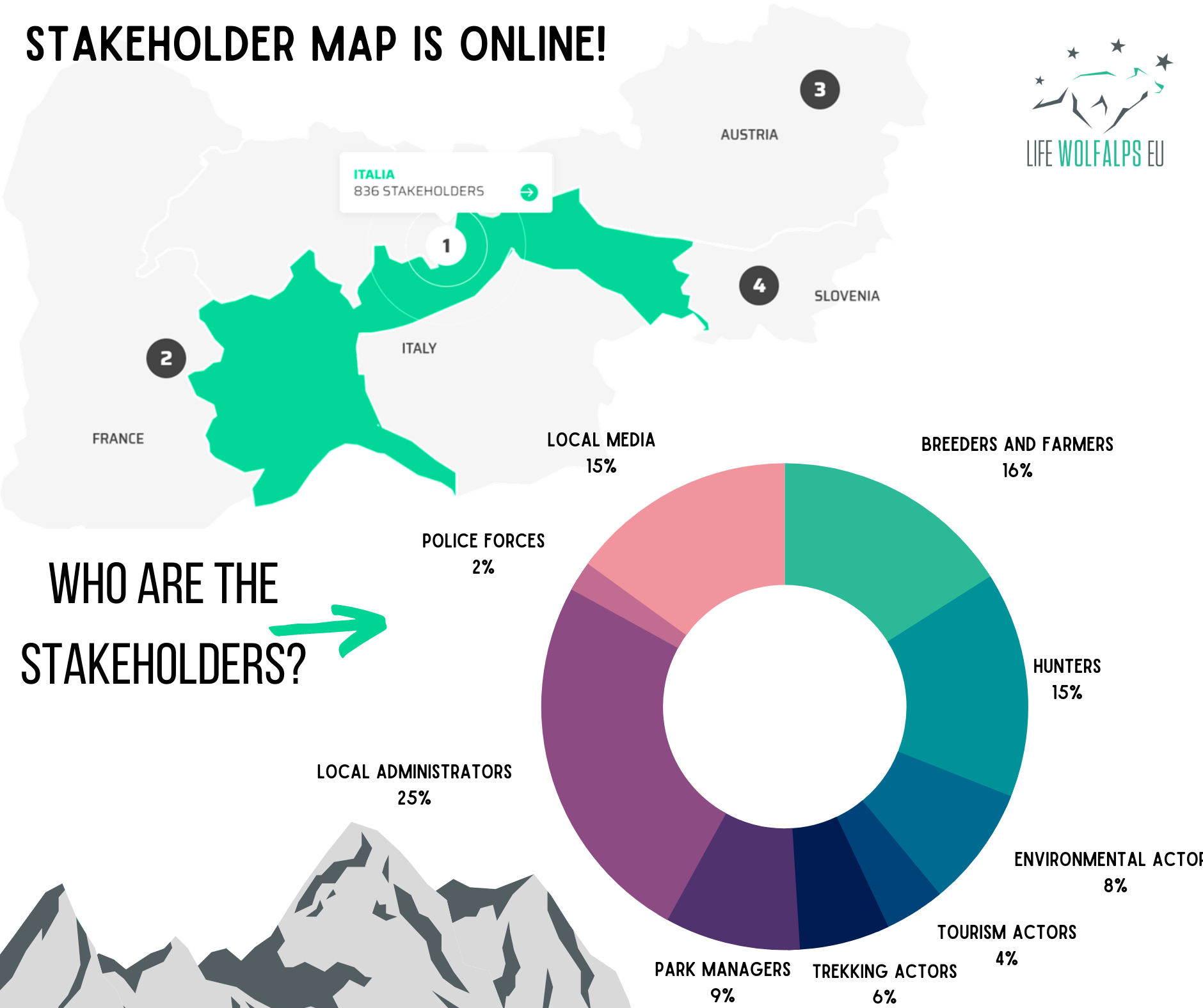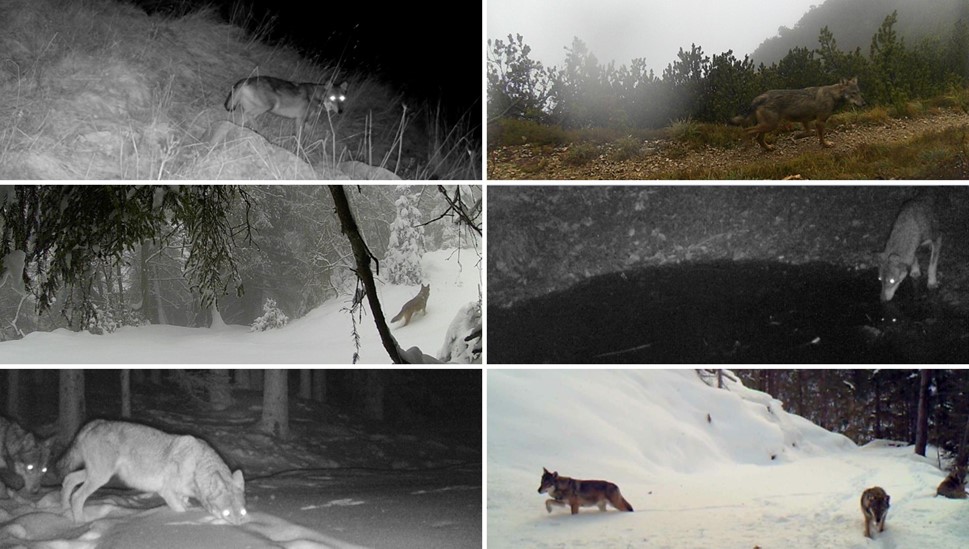Large Carnivores
The MUSE’s Vertebrate Zoology Section collaborates with various projects dedicated to large carnivore conservation (grey wolf and brown bear in particular), working in the field of communication and in that of research. It also contributes to the preparation of the annual Large Carnivore Technical Report published by the Autonomous Province of Trento.
LIFE WolfAlps EU
After a long absence, the wolf has spontaneously returned to Trentino. The species is present in the Alps since more than 20 years: starting from the western side, it has gradually expanded to the east, recolonizing the alpine arch. The first signs of single wolves in the province date back to 2006, but it is only in 2012 that, on Lessinia Mountains (between Trentino and Verona provinces), the first wolf couple met and established. The two wolves are Giulietta, a female from the western alps, and Slavc, a male coming from Slovenia, which dispersal travel has been recorder thanks to its GPS collar.
Starting from 2013, the couple has started to reproduce, giving birth to the first wolf pack of the territory. In 2020, wolf packs in Trentino province are at least 17, most of which have their territory on the border with Veneto. 2013 is also the year when the first LIFE WolfAlps project (LIFE12 NAT/IT/000807 LIFE WOLFALPS – Il lupo nelle Alpi: azioni coordinate per la conservazione del lupo nelle aree chiave e sull’intero arco alpino) has started. The project involved Italian and Slovenian partners and focused on wolf conservation on the Alps and ended in 2018. MUSE, as a partner of the project, has coordinated, together with Parco Naturale delle Alpi Marittime, the actions dedicated to communication.

Infographic showing the results of the stakeholder mapping process carried out by the project LWA EU at the alpine level.
The positive experience resulted from the first project led, in 2019, to a second one, the LIFE WolfAlps EU, this time extended to two more alpine partners: Austria and France, that joined Italy and Slovenia. The project, that will end in 2024, counts on 20 partners and aims at improving coexistence between wolves and humans at the alpine scale. MUSE has a key role in such goal, by coordinating the actions related to communication and stakeholder engagement.
MUSE is also participating to the national wolf monitoring program started in 2020-2021, by coordinating the activities at the provincial level. Such monitoring is part of an ambitious project coordinated at the national level by ISPRA and at the alpine level by the LIFE WolfAlps EU project. In the province, besides MUSE and PAT, other entities and local associations have contributed in the data collection: Associazione Cacciatori Trentini, SAT, Io non ho paura del lupo, WWF, AIGAE. From October to March, monitoring transects have been monthly checked by the monitoring team in search of wolf presence signs (mainly scats and tracks in the snow). To such data collection, data from camera trapping has also been added. Camera traps are extremely useful to various aims: to confirm the species’ presence in a given area, contribute in estimating numbers of packs and individuals, verify reproduction events and potential occurrence of anomalous phenotypes that might indicate disease or hybridization.
MUSE-PAT volunteers group for large carnivores
In 2020, the volunteers group of PAT and MUSE has officially established. Such group has been supporting PAT and MUSE for years with their work, and contributed to the monitoring of brown bears and wolves (but also other wildlife) on the territory. This group is made of passionate and skilled people that provide their time, tools and experience to improve knowledge on the local populations of large carnivores. They also provide communications material for the public, and participate in research projects such as camera-traps monitoring.

Photos from camera traps obtained in the data collection period 2020-2021 (from above left: M. Vettorazzi, F. Cadonna/F. Limelli, G. Pinter, F. Pizzedaz Trentini, G. Listorti, E. Ferraro).
Research projects
Systematic teriofauna monitoring through camera trapping
The study of wild mammals in their environment is often complex due to their typical elusiveness. Many of these species tend to avoid close contacts with humans, are nocturnal or/and live in non-easily accessible habitats, that make their direct observation challenging. Camera traps, cameras that are able to automatically record the passage of any subject thanks to their heat-movement sensor, represent an effective tool to collect precious data on the distribution and behaviour of such species, without disturbing them.
MUSE, in collaboration with Settore Grandi Carnivori della Provincia Autonoma di Trento, has started, in 2015, a long term monitoring project of medium and large-sized teriofauna through the use of camera traps in a study area of western Trentino. Such area comprises the southern part of the Gruppo di Brenta mountain and the Paganella-Gazza massif, which are part of the Adamello Brenta Natural Park, and core area of the brown bear population. Such monitoring that, starting from 2019, counts on the scientific supervision of the Biology Department of the Università di Firenze, allows to collect robust data thanks to a systematic and standardized approach: monitoring sites are chosen as representative of the study area, are placed at fixed distances from one another, and are kept constant throughout the years.
Data collected so far have improved our understanding of the most important factors influencing space use and rhythms of activity of the whole mammal community, with particular attention to the effect of human presence on the mountains. Such presence, especially related to tourism and recreation, is particularly intense in summer, when the monitoring takes place. New dynamics could emerge from multi-annual analyses, thanks to the progressive enrichment of the database in the years.
Starting from 2020, MUSE has also established, in partnership with the l’Università di Firenze, a second study area for systematic monitoring in eastern Trentino, in collaboration with Parco Naturale Paneveggio – Pale di S. Martino. Here, the same systematic approach adopted in the first study area will allow to collect standardized data in this part of the province, and will improve our knowledge of medium and large-sized mammals in the central Alps, an ecosystem that hosts a high biodiversity but that is also highly exploited by humans.
Large carnivore-human interactions and the Human dimension
Large carnivores are charismatic species of known importance at the ecological level worldwide. However, conflicts with local communities that share the landscape with such predators are not irrelevant. Negative interactions vary depending on the species and the area of the world considered, and range from property damages (e.g., depredations on livestock, beehives, orchards etc.), to depredations on pets and, in extremely rare cases, to attacks on humans.
To such concrete damages we must add the occurrence, in some populations, of bold individuals that, although do not represent a direct threat to people and their activities, they certainly raise the attention and concerns of the local communities, journalists and politics. Such conflicts, together with the extremely elusive nature of these species and, as a consequence, the limited knowledge we have of them, have led to strong social and political conflicts related to the coexistence with these animals.
MUSE’s research focus on the analysis of factors and dynamics that lead to negative interactions between people and large carnivores, both from the social point of view (Human dimension) and the presence of these species, with the aim of improving the knowledge on such aspects thanks to a robust and evidence-based approach.
References
Here some of the latest scientific papers published by the Section’s researchers:
- Bombieri G., Penteriani V., Delgado M.M., Groff C., Pedrotti L. and Jerina K. 2021. Towards understanding bold behaviour of large carnivores: the case of brown bears in human-modified landscapes. Animal Conservation.
https://zslpublications.onlinelibrary.wiley.com/doi/10.1111/acv.12680 - Bombieri G., Naves J., […], Delgado M. M. 2019. Brown bear attacks on humans: a worldwide perspective. Scientific Reports. https://doi.org/10.1038/s41598-019-44341-w
- Bombieri et al. 2018. Patterns of wild carnivore attacks on humans in urban areas. Scientific Reports.
https://doi.org/10.1038/s41598-018-36034-7 - Bombieri et al. 2018. Content Analysis of Media Reports on Predator Attacks on Humans: Toward an Understanding of Human risk Perception and Predator Acceptance. BioScience https://doi.org/10.1093/biosci/biy072
- Corradini A., Randles M., Pedrotti L., van Loon E., Passoni G., Oberosler V., Rovero F., Tattoni C., Ciolli M. and Cagnacci F. 2021. Effects of cumulated outdoor activity on wildlife habitat use. Biological Conservation, 253, p.108818.
https://doi.org/10.1016/j.biocon.2020.108818 - Oberosler V., Groff C., Iemma A., Pedrini P. and Rovero F. 2017. The influence of human disturbance on occupancy and activity patterns of mammals in the Italian Alps from systematic camera trapping. Mammalian Biology 87, 50-61.
https://doi.org/10.1016/j.mambio.2017.05.005 - Oberosler V., Tenan S. and Rovero F. 2020. Spatial and temporal patterns of human avoidance by brown bears in a reintroduced population. Hystrix, 31(2). https://doi.org/10.4404/hystrix-00327-2020
